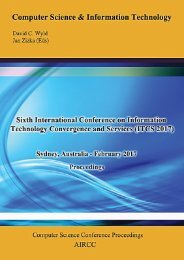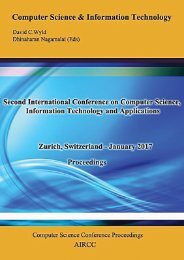CoSIT 2017
Fourth International Conference on Computer Science and Information Technology ( CoSIT 2017 ), Geneva, Switzerland - March 2017
Fourth International Conference on Computer Science and Information Technology ( CoSIT 2017 ), Geneva, Switzerland - March 2017
Create successful ePaper yourself
Turn your PDF publications into a flip-book with our unique Google optimized e-Paper software.
116 Computer Science & Information Technology (CS & IT)<br />
producing academically, i.e. publications, denoting his contributions and the topical domains he<br />
appears to be interested in. Yet, not only this kind of information it offers, but also one can infer<br />
the publications content by interpretation and analysis, their statistics and his relations. Apart<br />
from publications, a researcher tend to take part in activities revealing to some extent his<br />
proficiency level.<br />
Figure 1. Scholar’s Expertise Indicators<br />
Figure 1 shows a scholar’s expertise indicators. A scholar might be misjudged when evaluated<br />
only through his publications, for there are other unnoticed signs indicative of his expertise for<br />
example giving seminars, being part of conference committees, teaching courses and being<br />
honored and awarded. We aim at incorporating the conference memberships for it is important to<br />
study how good a scholar is at evaluating other scholars’ academic work, where the classical case<br />
ranks him only based on his own academic work. Our proposed approach uses learning to rank<br />
for its ability of combining heterogeneous features optimally in a supervised manner; in addition<br />
to using the author topic model (generative model) to estimate the relation between author and<br />
topic through unsupervised learning. The reason why we picked this model is because:<br />
publications’ abstracts are not always available which makes it pretty hard to know the topics of a<br />
publication when using LDA, i.e. authors’ information are not included, and it links authors to<br />
topics in a semantic manner.<br />
3. THE PROPOSED APPROACH<br />
We aim at building an expert seeking system with the purpose of enhancing the retrieval<br />
effectiveness through adding non-traditional features by taking advantage of conference<br />
memberships following the intuition that such positions are not assigned spontaneously.<br />
Additionally, we believe that a scholars’ publications conference rank, to some extent, matter; for<br />
experts usually publish their valuable work in top-ranked conferences. The more he publish in<br />
top-ranked conferences, the more valuable his work is. Our system is called “Multi-Feature Based<br />
Expert Seeking System” (FeBES) because it uses multiple features extracted from different<br />
sources to estimate scholars’ expertise. In this section, the proposed model’s concepts are<br />
provided, including the model’s architecture, procedure and desirable features on which we will<br />
count to determine how professional scholars are given a domain.





